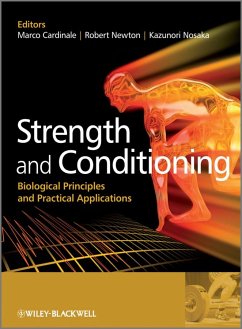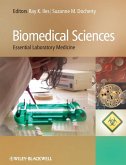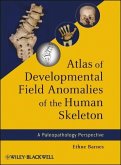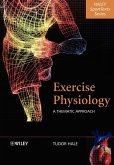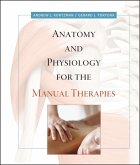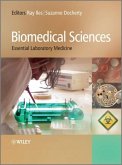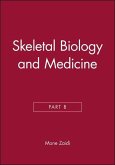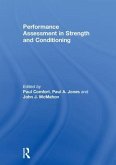Marco Cardinale, Robert Newton, Kazunori NosakaBiological Principles and Practical Applications
Strength and Conditioning
Biological Principles and Practical Applications
Herausgegeben von Cardinale, Marco; Newton, Robert; Nosaka, Kazunori
Marco Cardinale, Robert Newton, Kazunori NosakaBiological Principles and Practical Applications
Strength and Conditioning
Biological Principles and Practical Applications
Herausgegeben von Cardinale, Marco; Newton, Robert; Nosaka, Kazunori
- Broschiertes Buch
- Merkliste
- Auf die Merkliste
- Bewerten Bewerten
- Teilen
- Produkt teilen
- Produkterinnerung
- Produkterinnerung
"I recommend that you read and use the information in this book to provide your athletes with the best chances of performing at their best" from the foreword by Sir Clive Woodward, Olympic Performance Director, British Olympic Association
This book provides the latest scientific and practical information in the field of strength and conditioning.
The text is presented in four sections, the first of which covers the biological aspects of the subject, laying the foundation for a better understanding of the second on the biological responses to strength and conditioning programs. Section…mehr
Andere Kunden interessierten sich auch für
![Biomedical Sciences Biomedical Sciences]() Stephen ButlerBiomedical Sciences100,99 €
Stephen ButlerBiomedical Sciences100,99 €![Atlas of Developmental Field Anomalies of the Human Skeleton Atlas of Developmental Field Anomalies of the Human Skeleton]() Ethne BarnesAtlas of Developmental Field Anomalies of the Human Skeleton173,99 €
Ethne BarnesAtlas of Developmental Field Anomalies of the Human Skeleton173,99 €![Exercise Physiology Exercise Physiology]() Tudor HaleExercise Physiology80,99 €
Tudor HaleExercise Physiology80,99 €![Anatomy and Physiology for the Manual Therapies Anatomy and Physiology for the Manual Therapies]() Andrew KuntzmanAnatomy and Physiology for the Manual Therapies254,99 €
Andrew KuntzmanAnatomy and Physiology for the Manual Therapies254,99 €![Biomedical Sciences Biomedical Sciences]() Biomedical Sciences186,99 €
Biomedical Sciences186,99 €![Skeletal Biology and Medicine, Part B Skeletal Biology and Medicine, Part B]() Mone ZaidiSkeletal Biology and Medicine, Part B175,99 €
Mone ZaidiSkeletal Biology and Medicine, Part B175,99 €![Performance Assessment in Strength and Conditioning Performance Assessment in Strength and Conditioning]() Performance Assessment in Strength and Conditioning180,99 €
Performance Assessment in Strength and Conditioning180,99 €-
-
-
"I recommend that you read and use the information in this book to provide your athletes with the best chances of performing at their best"
from the foreword by Sir Clive Woodward, Olympic Performance Director, British Olympic Association
This book provides the latest scientific and practical information in the field of strength and conditioning.
The text is presented in four sections, the first of which covers the biological aspects of the subject, laying the foundation for a better understanding of the second on the biological responses to strength and conditioning programs. Section three deals with the most effective monitoring strategies for evaluating a training program and establishing guidelines for writing a successful strength and conditioning program. The final section examines the role of strength and conditioning as a rehabilitation tool and as applied to those with disabilities.
This book is an invaluable textbook and reference both for academic programs and for the continuing education of sports professionals.
Integrates the latest research on physiological, anatomical and biomechanical aspects of strength and conditioning
Offers numerous practical examples of applications
Provides guidelines for writing and monitoring effective strength training programs
Hinweis: Dieser Artikel kann nur an eine deutsche Lieferadresse ausgeliefert werden.
from the foreword by Sir Clive Woodward, Olympic Performance Director, British Olympic Association
This book provides the latest scientific and practical information in the field of strength and conditioning.
The text is presented in four sections, the first of which covers the biological aspects of the subject, laying the foundation for a better understanding of the second on the biological responses to strength and conditioning programs. Section three deals with the most effective monitoring strategies for evaluating a training program and establishing guidelines for writing a successful strength and conditioning program. The final section examines the role of strength and conditioning as a rehabilitation tool and as applied to those with disabilities.
This book is an invaluable textbook and reference both for academic programs and for the continuing education of sports professionals.
Integrates the latest research on physiological, anatomical and biomechanical aspects of strength and conditioning
Offers numerous practical examples of applications
Provides guidelines for writing and monitoring effective strength training programs
Hinweis: Dieser Artikel kann nur an eine deutsche Lieferadresse ausgeliefert werden.
Produktdetails
- Produktdetails
- Verlag: Wiley & Sons
- 1. Auflage
- Seitenzahl: 496
- Erscheinungstermin: 20. Dezember 2010
- Englisch
- Abmessung: 260mm x 200mm x 29mm
- Gewicht: 1070g
- ISBN-13: 9780470019191
- ISBN-10: 0470019190
- Artikelnr.: 32568046
- Herstellerkennzeichnung
- Libri GmbH
- Europaallee 1
- 36244 Bad Hersfeld
- gpsr@libri.de
- Verlag: Wiley & Sons
- 1. Auflage
- Seitenzahl: 496
- Erscheinungstermin: 20. Dezember 2010
- Englisch
- Abmessung: 260mm x 200mm x 29mm
- Gewicht: 1070g
- ISBN-13: 9780470019191
- ISBN-10: 0470019190
- Artikelnr.: 32568046
- Herstellerkennzeichnung
- Libri GmbH
- Europaallee 1
- 36244 Bad Hersfeld
- gpsr@libri.de
Dr. Marco Cardinale is the Head of Sports Physiology at Aspire Academy in Qatar. He was the former Head of Sports Science and Research of the British Olympic Association. Robert Newton is the editor of Strength and Conditioning: Biological Principles and Practical Applications, published by Wiley. Kazunori Nosaka is the editor of Strength and Conditioning: Biological Principles and Practical Applications, published by Wiley.
Foreword (Sir Clive Woodward).
Preface.
List of Contributors.
Section 1 Strengthand Conditioning Biology.
1.1 Skeletal Muscle Physiology (Valmor Tricoli).
1.1.1 Introduction.
1.1.2 Skeletal muscle macrostructure.
1.1.3 Skeletal muscle microstructure.
1.1.4 Contraction mechanism.
1.1.5 Muscle fibre types.
1.1.6 Muscle architecture.
1.1.7 Hypertrophy and hyperplasia.
1.1.8 Satellite cells.
1.2 Neuromuscular Physiology (Alberto Rainoldi and Marco Gazzoni).
1.2.1 The neuromuscular system.
1.2.2 Muscle fatigue.
1.2.3 Muscle function assessment.
1.3 Bone Physiology (Jörn Rittweger).
1.3.1 Introduction.
1.3.2 Bone anatomy.
1.3.3 Bone biology.
1.3.4 Mechanical functions of bone.
1.3.5 Adaptive processes in bone.
1.3.6 Endocrine involvement of bone.
1.4 Tendon Physiology (Nicola Maffulli, Umile Giuseppe Longo, Filippo
Spiezia and Vincenzo Denaro).
1.4.1 Tendons.
1.4.2 The musculotendinous junction.
1.4.3 The osteotendinous junction.
1.4.4 Nerve supply.
1.4.5 Blood supply.
1.4.6 Composition.
1.4.7 Collagen formation.
1.4.8 Cross-links.
1.4.9 Elastin.
1.4.10 Cells.
1.4.11 Ground substance.
1.4.12 Crimp.
1.5 Bioenergetics of Exercise (R.J. Maughan).
1.5.1 Introduction.
1.5.2 Exercise, energy, work, and power.
1.5.3 Sources of energy.
1.5.4 The tricarboxylic acid (TCA) cycle.
1.5.5 Oxygen delivery.
1.5.6 Energy stores.
1.5.7 Conclusion.
1.6 Respiratory and Cardiovascular Physiology (Jeremiah J. Peiffer and
Chris R. Abbiss).
1.6.1 The respiratory system.
1.6.2 The cardiovascular system.
1.6.3 Conclusion.
1.7 Genetic and Signal Transduction Aspects of Strength Training (Henning
Wackerhage, Arimantas Lionikas, Stuart Gray and Aivaras Ratkevicius).
1.7.1 Genetics of strength and trainability.
1.7.2 Signal transduction pathways that mediate the adaptation to strength
training.
1.8 Strength and Conditioning Biomechanics (Robert U. Newton).
1.8.1 Introduction.
1.8.2 Biomechanical concepts for strength and conditioning.
1.8.3 The force-velocity-power relationship.
1.8.4 Musculoskeletal machines.
1.8.5 Biomechanics of muscle function.
1.8.6 Body size, shape, and power-to-weight ratio.
1.8.7 Balance and stability.
1.8.8 The stretch-shortening cycle.
1.8.9 Biomechanics of resistance machines.
1.8.10 Machines vs free weights.
1.8.11 Conclusion.
Section 2 Physiological adaptations to strength and conditioning.
2.1 Neural Adaptations to Resistance Exercise (Per Aagaard).
2.1.1 Introduction.
2.1.2 Effects of strength training on mechanical muscle function.
2.1.3 Effects of strength training on neural function.
2.1.4 Conclusion.
2.2 Structural and Molecular Adaptations to Training (Jesper L. Andersen).
2.2.1 Introduction.
2.2.2 Protein synthesis and degradation in human skeletal muscle.
2.2.3 Muscle hypertrophy and atrophy.
2.2.4 What is the significance of satellite cells in human skeletal muscle?
2.2.5 Concurrent strength and endurance training: consequences for muscle
adaptations.
2.3 Adaptive Processes in Human Bone and Tendon (Constantinos N. Maganaris,
Jörn Rittweger and Marco V. Narici).
2.3.1 Introduction.
2.3.2 Bone.
2.3.3 Tendon.
2.3.4 Conclusion.
2.4 Biomechanical Markers and Resistance Training (Christian Cook and Blair
Crewther).
2.4.1 Introduction.
2.4.2 Testosterone responses to resistance training.
2.4.3 Cortisol responses to resistance training.
2.4.4 Dual actions of testosterone and cortisol.
2.4.5 Growth hormone responses to resistance training.
2.4.6 Other biochemical markers.
2.4.7 Limitations in the use and interpretation of biochemical markers.
2.4.8 Applications of resistance training.
2.4.9 Conclusion.
2.5 Cardiovascular Adaptations to Strength and Conditioning (Andy Jones and
Fred DiMenna).
2.5.1 Introduction.
2.5.2 Cardiovascular function.
2.5.3 Cardiovascular adaptations to training.
2.5.4 Cardiovascular-related adaptations to training.
2.5.5 Conclusion.
2.6 Exercise-induced Muscle Damage and Delayed-onset Muscle Soreness (DOMS)
(Kazunori Nosaka).
2.6.1 Introduction.
2.6.2 Symptoms and markers of muscle damage.
2.6.3 Relationship between DOMS and other indicators.
2.6.4 Factors influencing the magnitude of muscle damage.
2.6.5 Muscle damage and training.
2.6.6 Conclusion.
2.7 Alternative Modalities of Strength and Conditioning: Electrical
Stimulation and Vibration (Nicola A. Maffiuletti and Marco Cardinale).
2.7.1 Introduction.
2.7.2 Electrical-stimulation exercise.
2.7.3 Vibration exercise.
2.8 The Stretch-Shortening Cycle (SSC) (Anthony Blazevich).
2.8.1 Introduction.
2.8.2 Mechanisms responsible for performance enhancement with the SSC.
2.8.3 Force unloading: a requirement for elastic recoil.
2.8.4 Optimum MTU properties for SSC performance.
2.8.5 Effects of the transition time between stretch and shortening on SSC
performance.
2.8.6 Conclusion.
2.9 Repeated-sprint Ability (RSA) (David Bishop and Olivier Girard).
2.9.1 Introduction.
2.9.2 Limiting factors.
2.9.3 Ergogenic aids and RSA.
2.9.4 Effects of training on RSA.
2.9.5 Conclusion.
2.10 The Overtraining Syndrome (OTS) (Romain Meeusen and Kevin De Pauw).
2.10.1 Introduction.
2.10.2 Definitions.
2.10.3 Prevalence.
2.10.4 Mechanisms and diagnosis.
2.10.5 Prevention.
2.10.6 Conclusion.
Section 3 Monitoring strength and conditioning progress.
3.1 Principles of Athlete Testing (Robert U. Newton and Marco Cardinale).
3.1.1 Introduction.
3.1.2 General principles of athlete testing.
3.1.3 Maximum strength.
3.1.4 Ballistic testing.
3.1.5 Reactive strength tests.
3.1.6 Eccentric strength tests.
3.1.7 Conclusion.
3.2 Speed and Agility Assessment (Warren Young and Jeremy Sheppard).
3.2.1 Speed.
3.2.2 Agility.
3.2.3 Conclusion.
3.3 Testing Anaerobic Capacity and Repeated-sprint Ability (David Bishop
and Matt Spencer).
3.3.1 Introduction.
3.3.2 Testing anaerobic capacity.
3.3.3 Testing repeated-sprint ability.
3.3.4 Conclusion.
3.4 Cardiovascular Assessment and Aerobic Training Prescription (Andy Jones
and Fred DiMenna).
3.4.1 Introduction.
3.4.2 Cardiovascular assessment.
3.4.3 Aerobic training prescription.
3.4.4 Conclusion.
3.5 Biochemical Monitoring in Strength and Conditioning (Michael R.
McGuigan and Stuart J. Cormack).
3.5.1 Introduction.
3.5.2 Hormonal monitoring.
3.5.3 Metabolic monitoring.
3.5.4 Immunological and haematological monitoring.
3.5.5 Practical application.
3.6 Body Composition: Laboratory and Field Methods of Assessment (Arthur
Stewart and Tim Ackland).
3.6.1 Introduction.
3.6.2 History of body composition methods.
3.6.3 Fractionation models for body composition.
3.6.4 Biomechanical imperatives for sports performance.
3.6.5 Methods of assessment.
3.6.6 Profiling.
3.6.7 Conclusion.
3.7 Total Athlete Management (TAM) and Performance Diagnosis (Robert U.
Newton and Marco Cardinale).
3.7.1 Total athlete management.
3.7.2 Performance diagnosis.
3.7.3 Conclusion.
Section 4 Practical applications.
4.1 Resistance Training Modes: A Practical Perspective (Michael H. Stone
and Margaret E. Stone).
4.1.1 Introduction.
4.1.2 Basic training principles.
4.1.3 Strength, explosive strength, and power.
4.1.4 Conclusion.
4.2 Training Agility and Change-of-direction Speed (CODS) (Jeremy Sheppard
and Warren Young).
4.2.1 Factors affecting agility.
4.2.2 Organization of training.
4.2.3 Change-of-direction speed.
4.2.4 Perceptual and decision-making factors.
4.2.5 Training agility.
4.2.6 Conclusion.
4.3 Nutrition for Strength Training (Christopher S. Shaw and Kevin D.
Tipton).
4.3.1 Introduction.
4.3.2 The metabolic basis of muscle hypertrophy.
4.3.3 Optimal protein intake.
4.3.4 Acute effects of amino acid/protein ingestion.
4.3.5 Conclusion.
4.4 Flexibility (William A. Sands).
4.4.1 Definitions.
4.4.2 What is stretching?
4.4.3 A model of effective movement: the integration of flexibility and
strength.
4.5 Sensorimotor Training (Urs Granacher, Thomas Muehlbauer, Wolfgang
Taube, Albert Gollhofer and Markus Gruber).
4.5.1 Introduction.
4.5.2 The importance of sensorimotor training to the promotion of postural
control and strength.
4.5.3 The effects of sensorimotor training on postural control and
strength.
4.5.4 Adaptive processes following sensorimotor training.
4.5.5 Characteristics of sensorimotor training.
4.5.6 Conclusion.
Section 5 Strength conditioning special cases.
5.1 Strength and Conditioning as a Rehabilitation Tool (Andreas
Schlumberger).
5.1.1 Introduction.
5.1.2 Neuromuscular effects of injury as a basis for rehabilitation
strategies.
5.1.3 Strength and conditioning in retraining of the neuromuscular system.
5.1.4 Conclusion.
5.2 Strength Training for Children and Adolescents (Avery D. Faigenbaum).
5.2.1 Introduction.
5.2.2 Risks and concerns associated with youth strength training.
5.2.3 The effectiveness of youth resistance training.
5.2.4 Physiological mechanisms for strength development.
5.2.5 Potential health and fitness benefits.
5.2.6 Youth strength-training guidelines.
5.2.7 Conclusion.
5.3 Strength and Conditioning Considerations for the Paralympic Athlete (
Mark Jarvis, Matthew Cook and Paul Davies).
5.3.1 Introduction.
5.3.2 Programming considerations.
5.3.3 Current controversies in Paralympic strength and conditioning.
5.3.4 Specialist equipment.
5.3.5 Considerations for specific disability groups.
5.3.6 Tips for more effective programming.
Index.
Preface.
List of Contributors.
Section 1 Strengthand Conditioning Biology.
1.1 Skeletal Muscle Physiology (Valmor Tricoli).
1.1.1 Introduction.
1.1.2 Skeletal muscle macrostructure.
1.1.3 Skeletal muscle microstructure.
1.1.4 Contraction mechanism.
1.1.5 Muscle fibre types.
1.1.6 Muscle architecture.
1.1.7 Hypertrophy and hyperplasia.
1.1.8 Satellite cells.
1.2 Neuromuscular Physiology (Alberto Rainoldi and Marco Gazzoni).
1.2.1 The neuromuscular system.
1.2.2 Muscle fatigue.
1.2.3 Muscle function assessment.
1.3 Bone Physiology (Jörn Rittweger).
1.3.1 Introduction.
1.3.2 Bone anatomy.
1.3.3 Bone biology.
1.3.4 Mechanical functions of bone.
1.3.5 Adaptive processes in bone.
1.3.6 Endocrine involvement of bone.
1.4 Tendon Physiology (Nicola Maffulli, Umile Giuseppe Longo, Filippo
Spiezia and Vincenzo Denaro).
1.4.1 Tendons.
1.4.2 The musculotendinous junction.
1.4.3 The osteotendinous junction.
1.4.4 Nerve supply.
1.4.5 Blood supply.
1.4.6 Composition.
1.4.7 Collagen formation.
1.4.8 Cross-links.
1.4.9 Elastin.
1.4.10 Cells.
1.4.11 Ground substance.
1.4.12 Crimp.
1.5 Bioenergetics of Exercise (R.J. Maughan).
1.5.1 Introduction.
1.5.2 Exercise, energy, work, and power.
1.5.3 Sources of energy.
1.5.4 The tricarboxylic acid (TCA) cycle.
1.5.5 Oxygen delivery.
1.5.6 Energy stores.
1.5.7 Conclusion.
1.6 Respiratory and Cardiovascular Physiology (Jeremiah J. Peiffer and
Chris R. Abbiss).
1.6.1 The respiratory system.
1.6.2 The cardiovascular system.
1.6.3 Conclusion.
1.7 Genetic and Signal Transduction Aspects of Strength Training (Henning
Wackerhage, Arimantas Lionikas, Stuart Gray and Aivaras Ratkevicius).
1.7.1 Genetics of strength and trainability.
1.7.2 Signal transduction pathways that mediate the adaptation to strength
training.
1.8 Strength and Conditioning Biomechanics (Robert U. Newton).
1.8.1 Introduction.
1.8.2 Biomechanical concepts for strength and conditioning.
1.8.3 The force-velocity-power relationship.
1.8.4 Musculoskeletal machines.
1.8.5 Biomechanics of muscle function.
1.8.6 Body size, shape, and power-to-weight ratio.
1.8.7 Balance and stability.
1.8.8 The stretch-shortening cycle.
1.8.9 Biomechanics of resistance machines.
1.8.10 Machines vs free weights.
1.8.11 Conclusion.
Section 2 Physiological adaptations to strength and conditioning.
2.1 Neural Adaptations to Resistance Exercise (Per Aagaard).
2.1.1 Introduction.
2.1.2 Effects of strength training on mechanical muscle function.
2.1.3 Effects of strength training on neural function.
2.1.4 Conclusion.
2.2 Structural and Molecular Adaptations to Training (Jesper L. Andersen).
2.2.1 Introduction.
2.2.2 Protein synthesis and degradation in human skeletal muscle.
2.2.3 Muscle hypertrophy and atrophy.
2.2.4 What is the significance of satellite cells in human skeletal muscle?
2.2.5 Concurrent strength and endurance training: consequences for muscle
adaptations.
2.3 Adaptive Processes in Human Bone and Tendon (Constantinos N. Maganaris,
Jörn Rittweger and Marco V. Narici).
2.3.1 Introduction.
2.3.2 Bone.
2.3.3 Tendon.
2.3.4 Conclusion.
2.4 Biomechanical Markers and Resistance Training (Christian Cook and Blair
Crewther).
2.4.1 Introduction.
2.4.2 Testosterone responses to resistance training.
2.4.3 Cortisol responses to resistance training.
2.4.4 Dual actions of testosterone and cortisol.
2.4.5 Growth hormone responses to resistance training.
2.4.6 Other biochemical markers.
2.4.7 Limitations in the use and interpretation of biochemical markers.
2.4.8 Applications of resistance training.
2.4.9 Conclusion.
2.5 Cardiovascular Adaptations to Strength and Conditioning (Andy Jones and
Fred DiMenna).
2.5.1 Introduction.
2.5.2 Cardiovascular function.
2.5.3 Cardiovascular adaptations to training.
2.5.4 Cardiovascular-related adaptations to training.
2.5.5 Conclusion.
2.6 Exercise-induced Muscle Damage and Delayed-onset Muscle Soreness (DOMS)
(Kazunori Nosaka).
2.6.1 Introduction.
2.6.2 Symptoms and markers of muscle damage.
2.6.3 Relationship between DOMS and other indicators.
2.6.4 Factors influencing the magnitude of muscle damage.
2.6.5 Muscle damage and training.
2.6.6 Conclusion.
2.7 Alternative Modalities of Strength and Conditioning: Electrical
Stimulation and Vibration (Nicola A. Maffiuletti and Marco Cardinale).
2.7.1 Introduction.
2.7.2 Electrical-stimulation exercise.
2.7.3 Vibration exercise.
2.8 The Stretch-Shortening Cycle (SSC) (Anthony Blazevich).
2.8.1 Introduction.
2.8.2 Mechanisms responsible for performance enhancement with the SSC.
2.8.3 Force unloading: a requirement for elastic recoil.
2.8.4 Optimum MTU properties for SSC performance.
2.8.5 Effects of the transition time between stretch and shortening on SSC
performance.
2.8.6 Conclusion.
2.9 Repeated-sprint Ability (RSA) (David Bishop and Olivier Girard).
2.9.1 Introduction.
2.9.2 Limiting factors.
2.9.3 Ergogenic aids and RSA.
2.9.4 Effects of training on RSA.
2.9.5 Conclusion.
2.10 The Overtraining Syndrome (OTS) (Romain Meeusen and Kevin De Pauw).
2.10.1 Introduction.
2.10.2 Definitions.
2.10.3 Prevalence.
2.10.4 Mechanisms and diagnosis.
2.10.5 Prevention.
2.10.6 Conclusion.
Section 3 Monitoring strength and conditioning progress.
3.1 Principles of Athlete Testing (Robert U. Newton and Marco Cardinale).
3.1.1 Introduction.
3.1.2 General principles of athlete testing.
3.1.3 Maximum strength.
3.1.4 Ballistic testing.
3.1.5 Reactive strength tests.
3.1.6 Eccentric strength tests.
3.1.7 Conclusion.
3.2 Speed and Agility Assessment (Warren Young and Jeremy Sheppard).
3.2.1 Speed.
3.2.2 Agility.
3.2.3 Conclusion.
3.3 Testing Anaerobic Capacity and Repeated-sprint Ability (David Bishop
and Matt Spencer).
3.3.1 Introduction.
3.3.2 Testing anaerobic capacity.
3.3.3 Testing repeated-sprint ability.
3.3.4 Conclusion.
3.4 Cardiovascular Assessment and Aerobic Training Prescription (Andy Jones
and Fred DiMenna).
3.4.1 Introduction.
3.4.2 Cardiovascular assessment.
3.4.3 Aerobic training prescription.
3.4.4 Conclusion.
3.5 Biochemical Monitoring in Strength and Conditioning (Michael R.
McGuigan and Stuart J. Cormack).
3.5.1 Introduction.
3.5.2 Hormonal monitoring.
3.5.3 Metabolic monitoring.
3.5.4 Immunological and haematological monitoring.
3.5.5 Practical application.
3.6 Body Composition: Laboratory and Field Methods of Assessment (Arthur
Stewart and Tim Ackland).
3.6.1 Introduction.
3.6.2 History of body composition methods.
3.6.3 Fractionation models for body composition.
3.6.4 Biomechanical imperatives for sports performance.
3.6.5 Methods of assessment.
3.6.6 Profiling.
3.6.7 Conclusion.
3.7 Total Athlete Management (TAM) and Performance Diagnosis (Robert U.
Newton and Marco Cardinale).
3.7.1 Total athlete management.
3.7.2 Performance diagnosis.
3.7.3 Conclusion.
Section 4 Practical applications.
4.1 Resistance Training Modes: A Practical Perspective (Michael H. Stone
and Margaret E. Stone).
4.1.1 Introduction.
4.1.2 Basic training principles.
4.1.3 Strength, explosive strength, and power.
4.1.4 Conclusion.
4.2 Training Agility and Change-of-direction Speed (CODS) (Jeremy Sheppard
and Warren Young).
4.2.1 Factors affecting agility.
4.2.2 Organization of training.
4.2.3 Change-of-direction speed.
4.2.4 Perceptual and decision-making factors.
4.2.5 Training agility.
4.2.6 Conclusion.
4.3 Nutrition for Strength Training (Christopher S. Shaw and Kevin D.
Tipton).
4.3.1 Introduction.
4.3.2 The metabolic basis of muscle hypertrophy.
4.3.3 Optimal protein intake.
4.3.4 Acute effects of amino acid/protein ingestion.
4.3.5 Conclusion.
4.4 Flexibility (William A. Sands).
4.4.1 Definitions.
4.4.2 What is stretching?
4.4.3 A model of effective movement: the integration of flexibility and
strength.
4.5 Sensorimotor Training (Urs Granacher, Thomas Muehlbauer, Wolfgang
Taube, Albert Gollhofer and Markus Gruber).
4.5.1 Introduction.
4.5.2 The importance of sensorimotor training to the promotion of postural
control and strength.
4.5.3 The effects of sensorimotor training on postural control and
strength.
4.5.4 Adaptive processes following sensorimotor training.
4.5.5 Characteristics of sensorimotor training.
4.5.6 Conclusion.
Section 5 Strength conditioning special cases.
5.1 Strength and Conditioning as a Rehabilitation Tool (Andreas
Schlumberger).
5.1.1 Introduction.
5.1.2 Neuromuscular effects of injury as a basis for rehabilitation
strategies.
5.1.3 Strength and conditioning in retraining of the neuromuscular system.
5.1.4 Conclusion.
5.2 Strength Training for Children and Adolescents (Avery D. Faigenbaum).
5.2.1 Introduction.
5.2.2 Risks and concerns associated with youth strength training.
5.2.3 The effectiveness of youth resistance training.
5.2.4 Physiological mechanisms for strength development.
5.2.5 Potential health and fitness benefits.
5.2.6 Youth strength-training guidelines.
5.2.7 Conclusion.
5.3 Strength and Conditioning Considerations for the Paralympic Athlete (
Mark Jarvis, Matthew Cook and Paul Davies).
5.3.1 Introduction.
5.3.2 Programming considerations.
5.3.3 Current controversies in Paralympic strength and conditioning.
5.3.4 Specialist equipment.
5.3.5 Considerations for specific disability groups.
5.3.6 Tips for more effective programming.
Index.
Foreword (Sir Clive Woodward).
Preface.
List of Contributors.
Section 1 Strengthand Conditioning Biology.
1.1 Skeletal Muscle Physiology (Valmor Tricoli).
1.1.1 Introduction.
1.1.2 Skeletal muscle macrostructure.
1.1.3 Skeletal muscle microstructure.
1.1.4 Contraction mechanism.
1.1.5 Muscle fibre types.
1.1.6 Muscle architecture.
1.1.7 Hypertrophy and hyperplasia.
1.1.8 Satellite cells.
1.2 Neuromuscular Physiology (Alberto Rainoldi and Marco Gazzoni).
1.2.1 The neuromuscular system.
1.2.2 Muscle fatigue.
1.2.3 Muscle function assessment.
1.3 Bone Physiology (Jörn Rittweger).
1.3.1 Introduction.
1.3.2 Bone anatomy.
1.3.3 Bone biology.
1.3.4 Mechanical functions of bone.
1.3.5 Adaptive processes in bone.
1.3.6 Endocrine involvement of bone.
1.4 Tendon Physiology (Nicola Maffulli, Umile Giuseppe Longo, Filippo
Spiezia and Vincenzo Denaro).
1.4.1 Tendons.
1.4.2 The musculotendinous junction.
1.4.3 The osteotendinous junction.
1.4.4 Nerve supply.
1.4.5 Blood supply.
1.4.6 Composition.
1.4.7 Collagen formation.
1.4.8 Cross-links.
1.4.9 Elastin.
1.4.10 Cells.
1.4.11 Ground substance.
1.4.12 Crimp.
1.5 Bioenergetics of Exercise (R.J. Maughan).
1.5.1 Introduction.
1.5.2 Exercise, energy, work, and power.
1.5.3 Sources of energy.
1.5.4 The tricarboxylic acid (TCA) cycle.
1.5.5 Oxygen delivery.
1.5.6 Energy stores.
1.5.7 Conclusion.
1.6 Respiratory and Cardiovascular Physiology (Jeremiah J. Peiffer and
Chris R. Abbiss).
1.6.1 The respiratory system.
1.6.2 The cardiovascular system.
1.6.3 Conclusion.
1.7 Genetic and Signal Transduction Aspects of Strength Training (Henning
Wackerhage, Arimantas Lionikas, Stuart Gray and Aivaras Ratkevicius).
1.7.1 Genetics of strength and trainability.
1.7.2 Signal transduction pathways that mediate the adaptation to strength
training.
1.8 Strength and Conditioning Biomechanics (Robert U. Newton).
1.8.1 Introduction.
1.8.2 Biomechanical concepts for strength and conditioning.
1.8.3 The force-velocity-power relationship.
1.8.4 Musculoskeletal machines.
1.8.5 Biomechanics of muscle function.
1.8.6 Body size, shape, and power-to-weight ratio.
1.8.7 Balance and stability.
1.8.8 The stretch-shortening cycle.
1.8.9 Biomechanics of resistance machines.
1.8.10 Machines vs free weights.
1.8.11 Conclusion.
Section 2 Physiological adaptations to strength and conditioning.
2.1 Neural Adaptations to Resistance Exercise (Per Aagaard).
2.1.1 Introduction.
2.1.2 Effects of strength training on mechanical muscle function.
2.1.3 Effects of strength training on neural function.
2.1.4 Conclusion.
2.2 Structural and Molecular Adaptations to Training (Jesper L. Andersen).
2.2.1 Introduction.
2.2.2 Protein synthesis and degradation in human skeletal muscle.
2.2.3 Muscle hypertrophy and atrophy.
2.2.4 What is the significance of satellite cells in human skeletal muscle?
2.2.5 Concurrent strength and endurance training: consequences for muscle
adaptations.
2.3 Adaptive Processes in Human Bone and Tendon (Constantinos N. Maganaris,
Jörn Rittweger and Marco V. Narici).
2.3.1 Introduction.
2.3.2 Bone.
2.3.3 Tendon.
2.3.4 Conclusion.
2.4 Biomechanical Markers and Resistance Training (Christian Cook and Blair
Crewther).
2.4.1 Introduction.
2.4.2 Testosterone responses to resistance training.
2.4.3 Cortisol responses to resistance training.
2.4.4 Dual actions of testosterone and cortisol.
2.4.5 Growth hormone responses to resistance training.
2.4.6 Other biochemical markers.
2.4.7 Limitations in the use and interpretation of biochemical markers.
2.4.8 Applications of resistance training.
2.4.9 Conclusion.
2.5 Cardiovascular Adaptations to Strength and Conditioning (Andy Jones and
Fred DiMenna).
2.5.1 Introduction.
2.5.2 Cardiovascular function.
2.5.3 Cardiovascular adaptations to training.
2.5.4 Cardiovascular-related adaptations to training.
2.5.5 Conclusion.
2.6 Exercise-induced Muscle Damage and Delayed-onset Muscle Soreness (DOMS)
(Kazunori Nosaka).
2.6.1 Introduction.
2.6.2 Symptoms and markers of muscle damage.
2.6.3 Relationship between DOMS and other indicators.
2.6.4 Factors influencing the magnitude of muscle damage.
2.6.5 Muscle damage and training.
2.6.6 Conclusion.
2.7 Alternative Modalities of Strength and Conditioning: Electrical
Stimulation and Vibration (Nicola A. Maffiuletti and Marco Cardinale).
2.7.1 Introduction.
2.7.2 Electrical-stimulation exercise.
2.7.3 Vibration exercise.
2.8 The Stretch-Shortening Cycle (SSC) (Anthony Blazevich).
2.8.1 Introduction.
2.8.2 Mechanisms responsible for performance enhancement with the SSC.
2.8.3 Force unloading: a requirement for elastic recoil.
2.8.4 Optimum MTU properties for SSC performance.
2.8.5 Effects of the transition time between stretch and shortening on SSC
performance.
2.8.6 Conclusion.
2.9 Repeated-sprint Ability (RSA) (David Bishop and Olivier Girard).
2.9.1 Introduction.
2.9.2 Limiting factors.
2.9.3 Ergogenic aids and RSA.
2.9.4 Effects of training on RSA.
2.9.5 Conclusion.
2.10 The Overtraining Syndrome (OTS) (Romain Meeusen and Kevin De Pauw).
2.10.1 Introduction.
2.10.2 Definitions.
2.10.3 Prevalence.
2.10.4 Mechanisms and diagnosis.
2.10.5 Prevention.
2.10.6 Conclusion.
Section 3 Monitoring strength and conditioning progress.
3.1 Principles of Athlete Testing (Robert U. Newton and Marco Cardinale).
3.1.1 Introduction.
3.1.2 General principles of athlete testing.
3.1.3 Maximum strength.
3.1.4 Ballistic testing.
3.1.5 Reactive strength tests.
3.1.6 Eccentric strength tests.
3.1.7 Conclusion.
3.2 Speed and Agility Assessment (Warren Young and Jeremy Sheppard).
3.2.1 Speed.
3.2.2 Agility.
3.2.3 Conclusion.
3.3 Testing Anaerobic Capacity and Repeated-sprint Ability (David Bishop
and Matt Spencer).
3.3.1 Introduction.
3.3.2 Testing anaerobic capacity.
3.3.3 Testing repeated-sprint ability.
3.3.4 Conclusion.
3.4 Cardiovascular Assessment and Aerobic Training Prescription (Andy Jones
and Fred DiMenna).
3.4.1 Introduction.
3.4.2 Cardiovascular assessment.
3.4.3 Aerobic training prescription.
3.4.4 Conclusion.
3.5 Biochemical Monitoring in Strength and Conditioning (Michael R.
McGuigan and Stuart J. Cormack).
3.5.1 Introduction.
3.5.2 Hormonal monitoring.
3.5.3 Metabolic monitoring.
3.5.4 Immunological and haematological monitoring.
3.5.5 Practical application.
3.6 Body Composition: Laboratory and Field Methods of Assessment (Arthur
Stewart and Tim Ackland).
3.6.1 Introduction.
3.6.2 History of body composition methods.
3.6.3 Fractionation models for body composition.
3.6.4 Biomechanical imperatives for sports performance.
3.6.5 Methods of assessment.
3.6.6 Profiling.
3.6.7 Conclusion.
3.7 Total Athlete Management (TAM) and Performance Diagnosis (Robert U.
Newton and Marco Cardinale).
3.7.1 Total athlete management.
3.7.2 Performance diagnosis.
3.7.3 Conclusion.
Section 4 Practical applications.
4.1 Resistance Training Modes: A Practical Perspective (Michael H. Stone
and Margaret E. Stone).
4.1.1 Introduction.
4.1.2 Basic training principles.
4.1.3 Strength, explosive strength, and power.
4.1.4 Conclusion.
4.2 Training Agility and Change-of-direction Speed (CODS) (Jeremy Sheppard
and Warren Young).
4.2.1 Factors affecting agility.
4.2.2 Organization of training.
4.2.3 Change-of-direction speed.
4.2.4 Perceptual and decision-making factors.
4.2.5 Training agility.
4.2.6 Conclusion.
4.3 Nutrition for Strength Training (Christopher S. Shaw and Kevin D.
Tipton).
4.3.1 Introduction.
4.3.2 The metabolic basis of muscle hypertrophy.
4.3.3 Optimal protein intake.
4.3.4 Acute effects of amino acid/protein ingestion.
4.3.5 Conclusion.
4.4 Flexibility (William A. Sands).
4.4.1 Definitions.
4.4.2 What is stretching?
4.4.3 A model of effective movement: the integration of flexibility and
strength.
4.5 Sensorimotor Training (Urs Granacher, Thomas Muehlbauer, Wolfgang
Taube, Albert Gollhofer and Markus Gruber).
4.5.1 Introduction.
4.5.2 The importance of sensorimotor training to the promotion of postural
control and strength.
4.5.3 The effects of sensorimotor training on postural control and
strength.
4.5.4 Adaptive processes following sensorimotor training.
4.5.5 Characteristics of sensorimotor training.
4.5.6 Conclusion.
Section 5 Strength conditioning special cases.
5.1 Strength and Conditioning as a Rehabilitation Tool (Andreas
Schlumberger).
5.1.1 Introduction.
5.1.2 Neuromuscular effects of injury as a basis for rehabilitation
strategies.
5.1.3 Strength and conditioning in retraining of the neuromuscular system.
5.1.4 Conclusion.
5.2 Strength Training for Children and Adolescents (Avery D. Faigenbaum).
5.2.1 Introduction.
5.2.2 Risks and concerns associated with youth strength training.
5.2.3 The effectiveness of youth resistance training.
5.2.4 Physiological mechanisms for strength development.
5.2.5 Potential health and fitness benefits.
5.2.6 Youth strength-training guidelines.
5.2.7 Conclusion.
5.3 Strength and Conditioning Considerations for the Paralympic Athlete (
Mark Jarvis, Matthew Cook and Paul Davies).
5.3.1 Introduction.
5.3.2 Programming considerations.
5.3.3 Current controversies in Paralympic strength and conditioning.
5.3.4 Specialist equipment.
5.3.5 Considerations for specific disability groups.
5.3.6 Tips for more effective programming.
Index.
Preface.
List of Contributors.
Section 1 Strengthand Conditioning Biology.
1.1 Skeletal Muscle Physiology (Valmor Tricoli).
1.1.1 Introduction.
1.1.2 Skeletal muscle macrostructure.
1.1.3 Skeletal muscle microstructure.
1.1.4 Contraction mechanism.
1.1.5 Muscle fibre types.
1.1.6 Muscle architecture.
1.1.7 Hypertrophy and hyperplasia.
1.1.8 Satellite cells.
1.2 Neuromuscular Physiology (Alberto Rainoldi and Marco Gazzoni).
1.2.1 The neuromuscular system.
1.2.2 Muscle fatigue.
1.2.3 Muscle function assessment.
1.3 Bone Physiology (Jörn Rittweger).
1.3.1 Introduction.
1.3.2 Bone anatomy.
1.3.3 Bone biology.
1.3.4 Mechanical functions of bone.
1.3.5 Adaptive processes in bone.
1.3.6 Endocrine involvement of bone.
1.4 Tendon Physiology (Nicola Maffulli, Umile Giuseppe Longo, Filippo
Spiezia and Vincenzo Denaro).
1.4.1 Tendons.
1.4.2 The musculotendinous junction.
1.4.3 The osteotendinous junction.
1.4.4 Nerve supply.
1.4.5 Blood supply.
1.4.6 Composition.
1.4.7 Collagen formation.
1.4.8 Cross-links.
1.4.9 Elastin.
1.4.10 Cells.
1.4.11 Ground substance.
1.4.12 Crimp.
1.5 Bioenergetics of Exercise (R.J. Maughan).
1.5.1 Introduction.
1.5.2 Exercise, energy, work, and power.
1.5.3 Sources of energy.
1.5.4 The tricarboxylic acid (TCA) cycle.
1.5.5 Oxygen delivery.
1.5.6 Energy stores.
1.5.7 Conclusion.
1.6 Respiratory and Cardiovascular Physiology (Jeremiah J. Peiffer and
Chris R. Abbiss).
1.6.1 The respiratory system.
1.6.2 The cardiovascular system.
1.6.3 Conclusion.
1.7 Genetic and Signal Transduction Aspects of Strength Training (Henning
Wackerhage, Arimantas Lionikas, Stuart Gray and Aivaras Ratkevicius).
1.7.1 Genetics of strength and trainability.
1.7.2 Signal transduction pathways that mediate the adaptation to strength
training.
1.8 Strength and Conditioning Biomechanics (Robert U. Newton).
1.8.1 Introduction.
1.8.2 Biomechanical concepts for strength and conditioning.
1.8.3 The force-velocity-power relationship.
1.8.4 Musculoskeletal machines.
1.8.5 Biomechanics of muscle function.
1.8.6 Body size, shape, and power-to-weight ratio.
1.8.7 Balance and stability.
1.8.8 The stretch-shortening cycle.
1.8.9 Biomechanics of resistance machines.
1.8.10 Machines vs free weights.
1.8.11 Conclusion.
Section 2 Physiological adaptations to strength and conditioning.
2.1 Neural Adaptations to Resistance Exercise (Per Aagaard).
2.1.1 Introduction.
2.1.2 Effects of strength training on mechanical muscle function.
2.1.3 Effects of strength training on neural function.
2.1.4 Conclusion.
2.2 Structural and Molecular Adaptations to Training (Jesper L. Andersen).
2.2.1 Introduction.
2.2.2 Protein synthesis and degradation in human skeletal muscle.
2.2.3 Muscle hypertrophy and atrophy.
2.2.4 What is the significance of satellite cells in human skeletal muscle?
2.2.5 Concurrent strength and endurance training: consequences for muscle
adaptations.
2.3 Adaptive Processes in Human Bone and Tendon (Constantinos N. Maganaris,
Jörn Rittweger and Marco V. Narici).
2.3.1 Introduction.
2.3.2 Bone.
2.3.3 Tendon.
2.3.4 Conclusion.
2.4 Biomechanical Markers and Resistance Training (Christian Cook and Blair
Crewther).
2.4.1 Introduction.
2.4.2 Testosterone responses to resistance training.
2.4.3 Cortisol responses to resistance training.
2.4.4 Dual actions of testosterone and cortisol.
2.4.5 Growth hormone responses to resistance training.
2.4.6 Other biochemical markers.
2.4.7 Limitations in the use and interpretation of biochemical markers.
2.4.8 Applications of resistance training.
2.4.9 Conclusion.
2.5 Cardiovascular Adaptations to Strength and Conditioning (Andy Jones and
Fred DiMenna).
2.5.1 Introduction.
2.5.2 Cardiovascular function.
2.5.3 Cardiovascular adaptations to training.
2.5.4 Cardiovascular-related adaptations to training.
2.5.5 Conclusion.
2.6 Exercise-induced Muscle Damage and Delayed-onset Muscle Soreness (DOMS)
(Kazunori Nosaka).
2.6.1 Introduction.
2.6.2 Symptoms and markers of muscle damage.
2.6.3 Relationship between DOMS and other indicators.
2.6.4 Factors influencing the magnitude of muscle damage.
2.6.5 Muscle damage and training.
2.6.6 Conclusion.
2.7 Alternative Modalities of Strength and Conditioning: Electrical
Stimulation and Vibration (Nicola A. Maffiuletti and Marco Cardinale).
2.7.1 Introduction.
2.7.2 Electrical-stimulation exercise.
2.7.3 Vibration exercise.
2.8 The Stretch-Shortening Cycle (SSC) (Anthony Blazevich).
2.8.1 Introduction.
2.8.2 Mechanisms responsible for performance enhancement with the SSC.
2.8.3 Force unloading: a requirement for elastic recoil.
2.8.4 Optimum MTU properties for SSC performance.
2.8.5 Effects of the transition time between stretch and shortening on SSC
performance.
2.8.6 Conclusion.
2.9 Repeated-sprint Ability (RSA) (David Bishop and Olivier Girard).
2.9.1 Introduction.
2.9.2 Limiting factors.
2.9.3 Ergogenic aids and RSA.
2.9.4 Effects of training on RSA.
2.9.5 Conclusion.
2.10 The Overtraining Syndrome (OTS) (Romain Meeusen and Kevin De Pauw).
2.10.1 Introduction.
2.10.2 Definitions.
2.10.3 Prevalence.
2.10.4 Mechanisms and diagnosis.
2.10.5 Prevention.
2.10.6 Conclusion.
Section 3 Monitoring strength and conditioning progress.
3.1 Principles of Athlete Testing (Robert U. Newton and Marco Cardinale).
3.1.1 Introduction.
3.1.2 General principles of athlete testing.
3.1.3 Maximum strength.
3.1.4 Ballistic testing.
3.1.5 Reactive strength tests.
3.1.6 Eccentric strength tests.
3.1.7 Conclusion.
3.2 Speed and Agility Assessment (Warren Young and Jeremy Sheppard).
3.2.1 Speed.
3.2.2 Agility.
3.2.3 Conclusion.
3.3 Testing Anaerobic Capacity and Repeated-sprint Ability (David Bishop
and Matt Spencer).
3.3.1 Introduction.
3.3.2 Testing anaerobic capacity.
3.3.3 Testing repeated-sprint ability.
3.3.4 Conclusion.
3.4 Cardiovascular Assessment and Aerobic Training Prescription (Andy Jones
and Fred DiMenna).
3.4.1 Introduction.
3.4.2 Cardiovascular assessment.
3.4.3 Aerobic training prescription.
3.4.4 Conclusion.
3.5 Biochemical Monitoring in Strength and Conditioning (Michael R.
McGuigan and Stuart J. Cormack).
3.5.1 Introduction.
3.5.2 Hormonal monitoring.
3.5.3 Metabolic monitoring.
3.5.4 Immunological and haematological monitoring.
3.5.5 Practical application.
3.6 Body Composition: Laboratory and Field Methods of Assessment (Arthur
Stewart and Tim Ackland).
3.6.1 Introduction.
3.6.2 History of body composition methods.
3.6.3 Fractionation models for body composition.
3.6.4 Biomechanical imperatives for sports performance.
3.6.5 Methods of assessment.
3.6.6 Profiling.
3.6.7 Conclusion.
3.7 Total Athlete Management (TAM) and Performance Diagnosis (Robert U.
Newton and Marco Cardinale).
3.7.1 Total athlete management.
3.7.2 Performance diagnosis.
3.7.3 Conclusion.
Section 4 Practical applications.
4.1 Resistance Training Modes: A Practical Perspective (Michael H. Stone
and Margaret E. Stone).
4.1.1 Introduction.
4.1.2 Basic training principles.
4.1.3 Strength, explosive strength, and power.
4.1.4 Conclusion.
4.2 Training Agility and Change-of-direction Speed (CODS) (Jeremy Sheppard
and Warren Young).
4.2.1 Factors affecting agility.
4.2.2 Organization of training.
4.2.3 Change-of-direction speed.
4.2.4 Perceptual and decision-making factors.
4.2.5 Training agility.
4.2.6 Conclusion.
4.3 Nutrition for Strength Training (Christopher S. Shaw and Kevin D.
Tipton).
4.3.1 Introduction.
4.3.2 The metabolic basis of muscle hypertrophy.
4.3.3 Optimal protein intake.
4.3.4 Acute effects of amino acid/protein ingestion.
4.3.5 Conclusion.
4.4 Flexibility (William A. Sands).
4.4.1 Definitions.
4.4.2 What is stretching?
4.4.3 A model of effective movement: the integration of flexibility and
strength.
4.5 Sensorimotor Training (Urs Granacher, Thomas Muehlbauer, Wolfgang
Taube, Albert Gollhofer and Markus Gruber).
4.5.1 Introduction.
4.5.2 The importance of sensorimotor training to the promotion of postural
control and strength.
4.5.3 The effects of sensorimotor training on postural control and
strength.
4.5.4 Adaptive processes following sensorimotor training.
4.5.5 Characteristics of sensorimotor training.
4.5.6 Conclusion.
Section 5 Strength conditioning special cases.
5.1 Strength and Conditioning as a Rehabilitation Tool (Andreas
Schlumberger).
5.1.1 Introduction.
5.1.2 Neuromuscular effects of injury as a basis for rehabilitation
strategies.
5.1.3 Strength and conditioning in retraining of the neuromuscular system.
5.1.4 Conclusion.
5.2 Strength Training for Children and Adolescents (Avery D. Faigenbaum).
5.2.1 Introduction.
5.2.2 Risks and concerns associated with youth strength training.
5.2.3 The effectiveness of youth resistance training.
5.2.4 Physiological mechanisms for strength development.
5.2.5 Potential health and fitness benefits.
5.2.6 Youth strength-training guidelines.
5.2.7 Conclusion.
5.3 Strength and Conditioning Considerations for the Paralympic Athlete (
Mark Jarvis, Matthew Cook and Paul Davies).
5.3.1 Introduction.
5.3.2 Programming considerations.
5.3.3 Current controversies in Paralympic strength and conditioning.
5.3.4 Specialist equipment.
5.3.5 Considerations for specific disability groups.
5.3.6 Tips for more effective programming.
Index.

